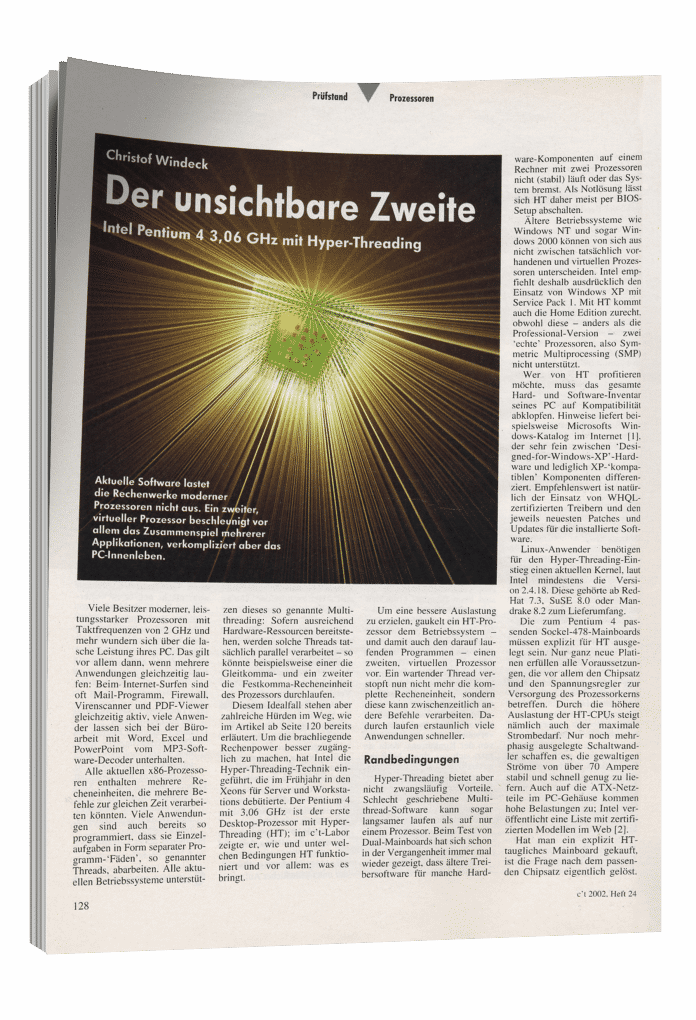
c’t magazin is celebrating its 40th birthday this year. We take this as an opportunity to pull some articles from our archive that are worth reading again. Among them are exciting investigative stories as well as oddities, great successes in computer technology, but also forecasts where we were completely wrong. We comment on the articles from today’s perspective and look forward to an entertaining journey through 40 years of IT history with you.
Processor leader Intel didn’t have it easy in 2002: The first AMD processors with the 64-bit “Hammer” design announced back in 1999 were about to be launched. Intel had nothing to counter that at the time. The alternative was to increase the computing power of the 32-bit systems.
Several processors on one board were very expensive solutions and more interesting for servers. Symmetric multiprocessing (SMP) meant two processor sockets on one board – several computing cores on one die only came years later. Higher clock frequencies were on the agenda anyway, but why not make better use of the processors that spend most of the time waiting for inputs and memory access?
Virtual add-on core
The solution was a virtual second processor core that occupied the CPU with additional tasks (threads) when some of the computing units were just twiddling their digital thumbs: Simultaneous Multithreading (SMT) – Intel Marketing invented the snappy name “Hyper-Threading” for it. Matthias Withopf explained this in his article “Virtual Tandem”:
“This expansion requires no more than 1 percent additional transistors and increases die area by just 1 percent.”

The operating system sees two processor cores in processors with Hyper-Threading (HT) and can distribute different tasks to them. Intel first used this technology in a Xeon server processor in early 2002. A Pentium 4 followed in November with a Northwood core and HT, which exceeded the clock limit of 3 gigahertz for the first time. However, HT is not a real symmetrical multiprocessing with two processors:
“The two Hyper-Threading processors have their own sets of registers as well as separate reorder and store buffers. They share the rest of the processor resources like brothers.”
With the first Pentium 4 with Hyper-Threading, Intel was therefore able to promise customers up to 35 percent more performance without much additional effort. However, the actual processor core did not calculate any faster and in order to utilize the additional performance of the tandem, an operating system that knew about SMT was required, which knows that there is only one physical core behind the two logical cores.
“Because the processors are not all equal, the ‘S’ in SMT does not mean ‘symmetrical’ as in SMP, but ‘simultaneous’.”

measured and felt

In c’t 24/2002, the subject of hyper-threading made it onto the cover for the first time.
Windows XT and Linux kernels from 2.14.18 were suitable for HT, the Windows versions NT and 2000, which were still widespread in 2002, had problems with this. In the practical test “The Invisible Second” Christof Windeck also stated:
“Hyper-threading doesn’t necessarily have advantages. Poorly written multi-threaded software can actually run slower than on a single processor.”
Appropriate benchmarks were also missing at the time; in 2002, most only determined the maximum performance of a system with single-threaded applications. Sometimes the c’t hardware testers have to fall back on their feelings:
“HT offers great advantages in terms of the computer’s reaction speed, a felt, subjective performance plus is particularly evident when working smoothly with many applications running at the same time.”
c’t retro article about Hyper-Threading:
(Bild: c’t 9/2023 )
If the WLAN in the study is too poor, then mesh WLAN can help. In c’t 9/2023 we explain what hardware is required and how to wire the base stations. The KI Stable Diffusion can also calculate impressive images on your own computer. c’t shows how to turn your graphics card into a brush. Are you probably also the IT support in your family and circle of friends? We’ll introduce three open source remote maintenance tools and walk you through installing them on your own server. We also travel back to 2002, when Intel presented the first consumer CPU with hyperthreading, the 3 GHz “Pentium 4”. You can read that and more in c’t 9/2023!
(rop)
